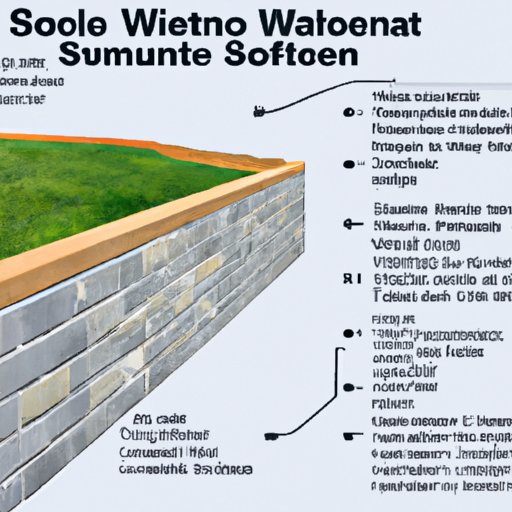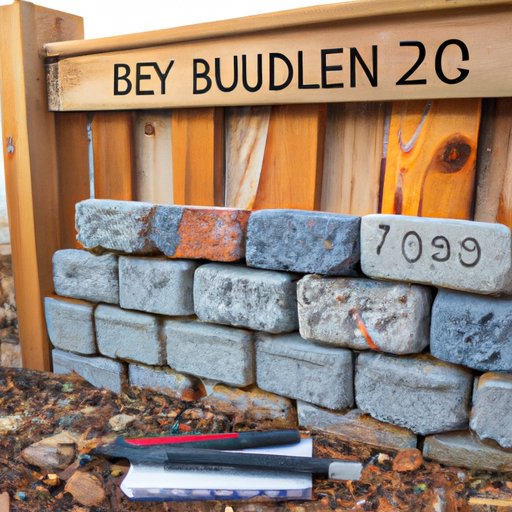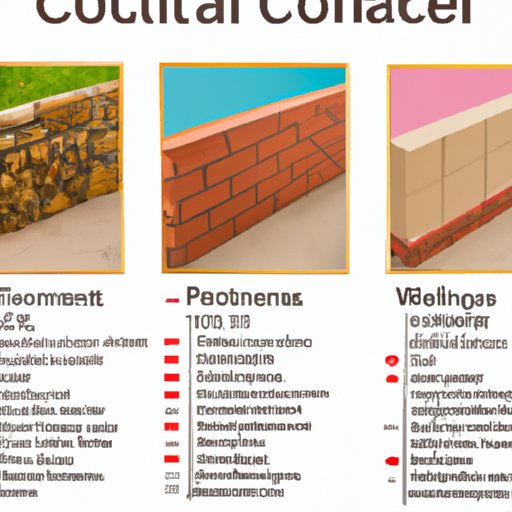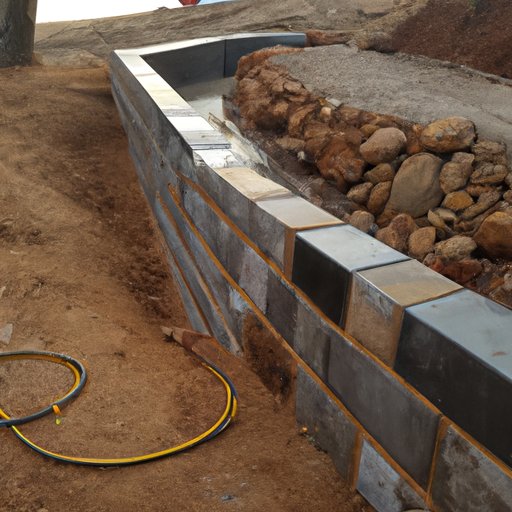Introduction
A retaining wall is a structure designed to hold soil or rock on one side of the wall while allowing the other side to remain free and clear. These walls are typically built along the perimeter of a property line, driveway, or walkway to provide additional support and stability. When properly constructed, they can help to prevent erosion and retain soil in place.
Retaining walls can be constructed from a variety of materials, including wood, stone, concrete, and more. They come in many sizes and designs, making them a versatile choice for any landscape. But before you get started, it’s important to understand the cost associated with building a retaining wall.

A Detailed Breakdown of the Cost to Build a Retaining Wall
The cost of building a retaining wall can vary significantly depending on the size, materials, location, and labor involved. Here’s a breakdown of the costs associated with building a retaining wall:
Labor Costs
The cost of labor will depend on the complexity of the project and the experience level of the workers. A basic wall may require only a few hours of work, while a more complex design could take days. On average, labor costs for a retaining wall can range from $25 to $50 per hour.
Materials Costs
The materials used to construct a retaining wall will also affect the overall cost. The type of material chosen will depend on the purpose of the wall, the desired look and feel, and the budget available. Common materials include wood, stone, concrete blocks, and bricks. Prices can range from $10 to $20 per square foot, depending on the quality and quantity of materials needed.
Additional Expenses
In addition to the labor and materials costs, there are other expenses that should be taken into consideration. These may include the cost of renting or purchasing tools and equipment, obtaining permits, and hiring an engineer or architect for specialized services. These costs can add up quickly, so it’s important to plan ahead and factor them into the total cost of the project.
The Average Price of Building a Retaining Wall
The average price of building a retaining wall can vary greatly depending on the size, materials, and other factors. Generally speaking, the cost of building a retaining wall can range from $1,500 to $15,000. However, complex designs and larger walls can cost much more than this.
Factors that Impact the Average Price
The cost of building a retaining wall can be impacted by several factors, including the size and design of the wall, the location and soil type, and whether the wall will be professionally installed or constructed as a DIY project. Additionally, the use of specialized materials and equipment can increase the overall cost.
What Factors Impact the Cost to Build a Retaining Wall?
When estimating the cost of building a retaining wall, there are several factors to consider. These may include the size and design of the wall, the location and soil type, and whether the wall will be professionally installed or constructed as a DIY project.
Size and Design of the Wall
The size and design of the wall will have a major impact on the cost of the project. A larger wall or one with a complex design will require more materials, labor, and time to complete, resulting in a higher cost. On the other hand, a smaller wall or one with a simpler design will require fewer materials and less labor, resulting in a lower cost.
Location and Soil Type
The location of the wall and the type of soil present can also affect the cost of the project. If the wall is being built on a slope, more excavation will be necessary and the cost will be higher. Additionally, if the soil is soft or sandy, the wall may need to be reinforced with additional materials to provide extra support.
Professional Installation or DIY
The decision to hire a professional to install the wall or attempt a DIY project can also affect the cost. Professional installation may be more expensive, but it can save time and ensure the wall is constructed correctly. On the other hand, attempting a DIY project can result in cost savings, but it’s important to ensure you have the necessary skills and knowledge before beginning.

How to Budget for Building a Retaining Wall
When budgeting for a retaining wall project, it’s important to account for all of the costs associated with the project. To do this, you’ll need to estimate the cost of materials, labor, and additional expenses. You should also factor in any unforeseen costs that may arise during the course of the project.
Estimating Costs
To accurately estimate the cost of building a retaining wall, you’ll need to get quotes from contractors and suppliers. This will give you a better idea of how much the project will cost and allow you to adjust your budget accordingly. Additionally, it’s important to make sure the contractor you choose is experienced and has a good reputation.
Prioritizing Necessary Components
Once you have an estimate of the project cost, you’ll need to prioritize which components are necessary and which can be eliminated to stay within your budget. For example, you may decide to use cheaper materials or opt for a simpler design to keep costs down. It’s also important to remember that cutting corners can lead to a subpar finished product.
DIY Retaining Wall Projects: How Much Will They Cost?
Attempting a DIY retaining wall project can be a great way to save money, but it’s important to understand the cost associated with the project. Depending on the size and complexity of the wall, the cost of materials may range from $400 to $2,000. Additionally, there may be additional costs associated with renting or purchasing tools and supplies.
Benefits of a DIY Project
In addition to the potential cost savings, there are other benefits to attempting a DIY project. Doing the work yourself can give you a sense of satisfaction and pride in the finished product. Additionally, it can be a great learning experience and provide valuable skills that can be applied to future projects.
Potential Cost Savings
By attempting a DIY project, you can potentially save money on labor costs. However, it’s important to factor in the cost of materials and tools, as well as the time it will take to complete the project. Additionally, you may need to hire a professional to inspect the finished product to ensure it meets safety standards.

Comparing Costs of Different Types of Retaining Walls
The cost of building a retaining wall will vary depending on the type of wall being constructed. Here’s a comparison of the different types of retaining walls and their associated costs:
Wood Retaining Walls
Wood retaining walls are generally the least expensive option and can range from $10 to $20 per square foot, depending on the type of wood and the amount of lumber needed. However, wood retaining walls require more maintenance than other types and may not be suitable for areas with high moisture levels.
Stone Retaining Walls
Stone retaining walls are more expensive than wood, but they are also more durable and require less maintenance. Stone retaining walls typically cost between $15 and $30 per square foot, depending on the type of stone and the amount needed.
Concrete Retaining Walls
Concrete retaining walls are the most expensive option, but they are also the most durable and require little to no maintenance. Concrete retaining walls can cost anywhere from $20 to $50 per square foot, depending on the complexity of the design and the amount of concrete needed.
Conclusion
Building a retaining wall can be a costly endeavor, but it can also add value to your property and improve the appearance of your landscape. Understanding the cost associated with the project and taking the time to plan ahead can help to ensure that you stay within your budget. By considering the size and design of the wall, the location and soil type, and whether to hire a professional or attempt a DIY project, you can make sure that your retaining wall project is successful and cost-effective.
(Note: Is this article not meeting your expectations? Do you have knowledge or insights to share? Unlock new opportunities and expand your reach by joining our authors team. Click Registration to join us and share your expertise with our readers.)
